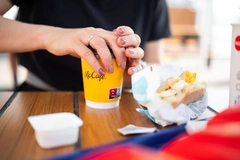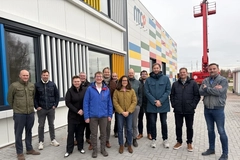Recycling infrastructural gaps hinder 2025 circularity goals, Rabobank finds

28 Jun 2023 --- Rabobank’s latest report reveals that investment and concrete actions are lacking in the face of increasing environmental protection pledges by the packaging industry. It states that the lack of investment in collection and recycling has left many producers wondering whether sustainable plastic alternatives are worth the higher costs, loss of efficiency and reduced shelf life if they have little chance of being recycled.
The report highlights that while over 500 influential organizations have committed to 2025 targets of entirely recyclable, compostable or reusable packaging, with the deadline less than two years away, serious investment is needed now to meet those goals.
“It would be very difficult for FMCG companies to 100% meet the 2025 goals, based on legacy formats and lack of investment needed to produce those formats with improved material compositions, that still might not meet recycling criteria,” Jim Owen, report author and plastic packaging senior analyst for North America at Rabobank, tells Packaging Insights.
Furthermore, Rabobank finds the lack of investment is “especially true” for flexible packaging recovery, as flexible substrates are often “the undesirables” at traditional material recovery facilities (MRFs), regardless of the material composition.
“The reality is FMCG companies could have done more but aren’t incentivized to be proactive given the costs and remaining challenges within the system,” stresses Owen.
 Rabobank highlights that with the 2025 deadline less than two years away, serious investment is needed now.Disconnect in the loop
Rabobank highlights that with the 2025 deadline less than two years away, serious investment is needed now.Disconnect in the loop
The Rabobank study finds that a large amount of recyclable waste never reaches recycling plants and ends up in landfills or incineration plants for energy recovery, even though recycling infrastructure and volumes have increased in Europe and North America.
It also finds that the high prices of recyclates, compared to their virgin counterparts, have led to low recycled material content in packaging. Increasing the recycling rates and availability of recyclates is likely to help make recyclates more affordable for packaging producers. Higher and more affordable availability of recyclates alongside regulatory changes is expected to increase the use of recycled content in packaging.
Regina Mestre, report author and plastic packaging analyst for Rabobank in Europe, tells us: “One of the largest barriers to recycling is collection infrastructure, more specifically separate collection infrastructure.”
“The highest recycling rates are achieved when waste is collected in separate streams, as it makes separation easier and the material that arrives is cleaner. Therefore, having more separate collection options available that are easily accessible and understandable for consumers is a way to increase the amount of plastic that can be recycled.”
The report details that an average of 13.3% of plastic packaging waste was recycled in 2021 in the US, while in the EU, an average of 38% was recycled in 2020. Mestre says governments and industry players must work together to ensure recycling infrastructure can handle the amount of plastic waste collected.
According to Rabobank, the industry must design for correct collection to increase the likelihood of proper disposal, including harmonizing labels between packaging and waste containers and decreasing the use of small parts or tethering them.
“Some design features of packaging can hinder recycling, such as dark colors in packaging that make separation difficult, certain colors in packaging that when recycled result in less desirable colors, small pieces in packaging, or use of more than one type of plastic in packaging,” says Mestre.
“Designing packaging with recycling in mind and moving toward standardization of design principles in the industry can increase recycling likelihood. For example, suppose most PET bottles are transparent when recycled. In that case, the resulting rPET can be used in these same bottles as color won’t be a concern (other than the natural degradation of rPET) the same way it would be if multiple-colored bottles were recycled.” A large amount of recyclable waste never reaches recycling plants and ends up in landfills or incineration plants for energy recovery.
A large amount of recyclable waste never reaches recycling plants and ends up in landfills or incineration plants for energy recovery.
Plan of action
Rabobank enlists five investments and trials that packaging producers need to start working on now to prepare for the (near) future:
- Having well-funded R&D departments that can articulate all the trade-offs, specify material and equipment needs, and begin understanding the implications for shelf life.
- Establishing partnerships with recyclers and resin processors and investing in recycling (both advanced and mechanical) to ensure one’s steady stream of recyclates.
- Educating consumers on packaging and adhering to How2Recycle guidelines to achieve higher recycling rates and greater access to recycled content.
- Discontinuing investment in outdated materials, working toward simplification with attention to end-of-life value.
- Being a part of extended producer responsibility (EPR) bill formation.
“Investments are needed all around. Governments, and ultimately Producer Responsibility Organizations, need to support increased roadside collection, build new MRFs, improve sortation technology and improve the carbon footprint of having to truck recyclates great distances to have a chance at a second life,” says Owen.
“Material manufacturers, companies running the equipment and machinery manufacturers should be supporting trials and downtime on existing equipment to help assess its ability to run new, recyclable material structures and assess potential trade-offs on shelf life, or consumer appeal.”
He reiterates that producer responsibility is a big step in the right direction though each state having a variation of the same rules causes confusion.
 According to Owen, producer responsibility is a big step in the right direction.Foreseeable future for EU and US
According to Owen, producer responsibility is a big step in the right direction.Foreseeable future for EU and US
The report’s authors highlight that while the EU and the US are rapidly changing legislation around managing plastic packaging and plastic packaging waste to achieve circularity, producer responsibility is “just getting started.”
“Its full effect won’t be seen for several years, but it’s hopeful to think that by 2030, with brands being forced to support sustainability through EPR rules, minimum PCR %, deposit returns, etc., more companies would come close to achieving their packaging sustainability targets,” says Owen.
The fastest growing and largest market for packaging is Asia, details Mestre. Focusing on the EU and US and how the global plastics treaty can address market differences and draft a regulation that could work for both: “A regulation that would work for both must take into consideration the differences between both regions in infrastructure, access to separate collection, different regulatory environments and existing regulations, and consumer preferences.”
She explains that a regulation for both could support producers in standardizing their practices and products across both regions and make them more sustainable in their production, distribution or end-of-life management.
“The packaging market in the US and in the EU are mature, established markets with steady growth. The plastic recycling infrastructure and collection systems are more robust in the EU than in the US. Additionally, the EU tends to be more regulated than the US, including packaging.”
By Radhika Sikaria











